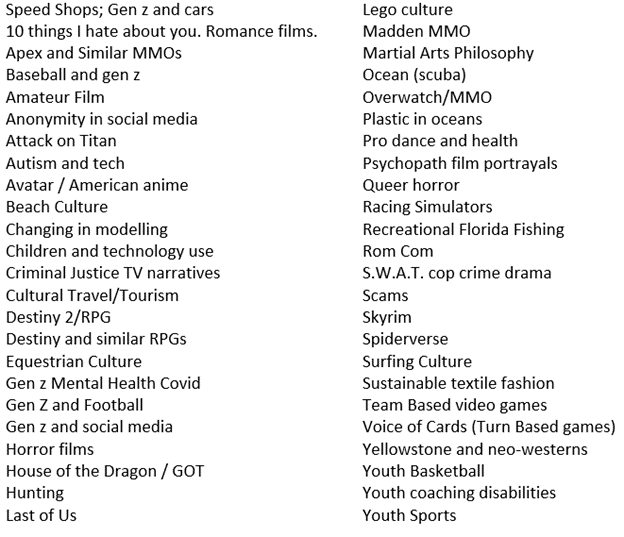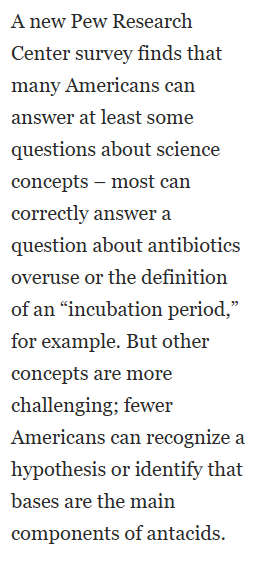Home / Composition 1 / Level 3
Level 3
Tracking sheets 1
Authored article on a website
Source for Tracking Sheet 1
- Authored articles on a website
Purpose:
- To record information about sources for the MLA paper.
- To maintain information concering the following:
- Be sure to read carefully the Caveats
- Look over the submission directions listed at the bottom of this page
Before you begin doing research
You'll need a topic
- As an in-person conversation between you and I, we'll determine a subject you have an interest in, a subject that you will be reading and writing about for the next two months.
- Not every subject works with this course. If I say no to a subject, I am saying no to the difficulty of the subject in relation to this course, and not to the subject itself.
- This is RESEARCH; not an essay. DO not. Do NOT. DO NOT think to contrive a thesis; all that you need at the moment is a subject that we agree on. (You'll acquire a theory in TS 9 to apply to the subject for the MLA paper)
- Subjects with some social element or some tangible element work best.
- Here are some examples students have come up with:
- Green Spaces
- The need for people to be in nature; specifically while living in city environments
- Greek Myths/Cosplay
- Cosplay interpretations of Greek Gods and MonstersDomestic violence
- Gen Z and Hobbies
- Hobbies have changed for the newest generation: Gen Z
- Children and Digital technologies
- Children's use of digital technologies
- Serial Killer representations in film.
- How serial killers are represented in film
- Green Spaces
- Here are some more examples
- This is not a list to choose from; if you do choose one of these, I most likely will say no, as I have just heard all about these subjects.

Process to find a subject
- What do you like to do?
- Simply said, what are your favourite activities when not working?
- What is your career goal/discipline for future degrees?
- Think about what career you are seeking, or what degree you are ultimately seeking.
Here's the process of Tracking Sheets
- Find and read an authored article on a website that concerns your subject. Hint: Use the News tab on Google.
- Do not use online databases of artciles; if you do not know the difference, ask me in class or by email if your article is from a website or an online database.
- Choose carefully. What YOU choose determines the focus within your subject. Though you have chosen a broad topic to research, this first source will set the more specific focus of your research and future sources.
- For instance if your topic is "Children's use of digital technologies" and you select the first source to be about phone app games, then the next sources in the next levels will have to concern children and phone app games.
- If you choose an article about children and social media, then the rest of your research will focus on children and social media (not app games, not video games, not any other part of digital technology
The Citation Section
- Open a blank Word document and save that document as annotatedbibliography.docx
- Download the Tracking Sheet
- You can use Purdue's Online Writing Lab (Owl) or my color-coded abridged version on Inverseintuition.org:
- If you use a citation maker, or any other source than the two listed above, and the citation does not match one of the two sources above, the citation is incorrect.
- If I mark something wrong on your Works Cited, but you think it is correct, your only defense is to show me how you followed a page on OWL or on InverseIntuition.org
- Look at the citation on OWL or Inverse to determine what should be listed in the Citation Section of the Tracking Sheet.
- Type your answers into the document you named annotatedbibliography.docx.
- Copy and paste all of your answers from that annotatedbibliography.docx document into the Tracking Sheet.
1. Main Container
- Write about what the website typically covers as topics in 3-5 sentences
- Peruse the website
- Or, find the website's About page.
- Do not quote any information.
- Do not use any pus words
- Begin with these words The website [Web Site Name goes here]...
- Type the response to this section into the annotatedbibliography.docx that you created, then copy and paste them from that file into the tracking sheet.
2. Second Container
- In the SECOND CONTAINER must begin with these words: The article "Article Name goes here" ...
- Summarize the article in 3-5 sentences
- Weave 2-4 quoted words per sentence
- Do not use or quote any pus words
- Your sentences must read AS IF the quote marks do not exist.
- Example excerpt of an article and example weaving a quoted part into a sentence:

- The article discusses how even though many Americans have a sound scientific understanding about some science, less Americans can "recognize a hypothesis" or properly identify acids to bases.
- The above example paraphrases the ideas in part of the article but directly weaves a quoted part from the article into the sentence.
- If you read that example sentence out-loud to someone else, that listener would have no idea what words were quoted; that's what you want to achieve.
- A listener would have to read the quote to see the quote marks.
- Type the response to this section into the annotatedbibliography.docx that you created, then copy and paste them from that file into the tracking sheet.
- You MUST submit Proofs of each of the 3-5 quoted parts.
- You must submit two files in the same email when submitting this assignment
- The Tracking sheet
- File name: LastnameTrackingsheet1.docx
- A Word document that has a screen shot of the quoted areas of the article
- File Name: LastnameTrackingsheet1Proofs.docx
- The Tracking sheet
- How to make the proofs
- The proof needs to be a full screen screenshot of each area you are quoting in the paper.
- HIGHLIGHT the quoted passage before taking the screen shot.
- The screen shot must be a full screen shot of your whole screen; do not crop it.
- The screenshots must be pasted into a Word document (that must be submitted in the same email with the paper).
3. How It Helps
- Write how this article helps your research in 3-5 sentences
- The aim is to have you thinking more about the article than simple summary
- You can choose to discus a variety of information:
- Discuss new interesting ideas you just learned
- Discuss facts or figures that might seem extraordianry to people who do not know the subject of the article
- Or, discuss what new information or ideas the article covers that have not been discussed by anyone before the article
- Or discuss the article's concepts or ideas that relate to your topic
- Or, discuss how this article relates to another tracking sheet (once you have more than one tracking sheet done)
- Type the response to this section into the annotatedbibliography.docx that you created, then copy and paste them from that file into the tracking sheet.
4. Quoted passage
- Quote something from the article
- What you quote does not need to originally be in quote marks in the article
- Follow the Lead-in:"quote" that was done for Mini-research 2
- Add the proof for this quote in the Proofs document
Caveats
- No pus words allowed.
- Do not plagiarize. Use your own words
- If your quoted passage was already quoted in the article (the author quoted somebody else), you will need to indicate as such in your lead-in sentence. Below is an example of Susan Gomez quoting Joe Smith in her article, and you are using Joe Smith's quoted words:
- Joe Smith, in Susan Gomez's article "Blah de Blah," suggests we should choose words carefully: "Garbley garble garble garbley garble"
- Spelling counts
- This is also a training to have you test if a spell checker is active on any digital platform (college application sites, job application sites, pdfs for job aps, etc)
- The Tracking Sheet will not spell check for you
- If you use a word that Word would have flagged as incorrectly spelled, I will return the tracking sheet as Reviewed.
Submitting the assignment
- Submit both documents in one email
- The tracking sheet with the proper file name
- The Proofs Word document that has the 3-5 proofs from the 2. Second Container and the proof from the qouted area.
- You must submit two files in the same email when submitting this assignment